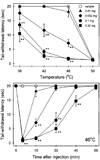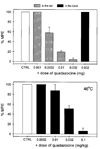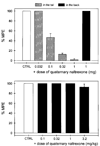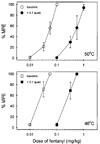The role of peripheral mu opioid receptors in the modulation of capsaicin-induced thermal nociception in rhesus monkeys
- PMID: 9655854
- PMCID: PMC2866037
The role of peripheral mu opioid receptors in the modulation of capsaicin-induced thermal nociception in rhesus monkeys
Abstract
Capsaicin produces burning pain, followed by nociceptive responses, such as allodynia and hyperalgesia in humans and rodents. In the present study, when administered subcutaneously into the tail of rhesus monkeys, capsaicin (0.01-0.32 mg) dose-dependently produced thermal allodynia manifested as reduced tail-withdrawal latencies in 46 degrees C water, from a maximum value of 20 sec to approximately 2 sec. Coadministration of selective mu opioid agonists, fentanyl (0.003-0.1 mg) and (D-Ala2,N-Me-Phe4, Gly5-ol)-enkephalin (0.001-0.03 mg), dose-dependently inhibited capsaicin-induced allodynia. This local antinociception was antagonized by small doses of opioid antagonists, quadazocine (0.03 mg) and quaternary naltrexone (1 mg), applied locally in the tail. However, these doses of antagonists injected s.c. in the back did not antagonize local fentanyl. Comparing the relative potency of either agonist or antagonist after local and systemic administration confirmed that the site of action of locally applied mu opioid agonists is in the tail. These results provide evidence that activation of peripheral mu opioid receptors can diminish capsaicin-induced allodynia in primates. This experimental pain model could be a useful tool for evaluating peripherally acting antinociceptive agents without central side effects and enhance new approaches to the treatment of inflammatory pain.
Figures





Similar articles
-
Local inhibitory effects of dynorphin A-(1-17) on capsaicin-induced thermal allodynia in rhesus monkeys.Eur J Pharmacol. 2000 Aug 18;402(1-2):69-76. doi: 10.1016/s0014-2999(00)00503-3. Eur J Pharmacol. 2000. PMID: 10940359 Free PMC article.
-
Activation of peripheral kappa opioid receptors inhibits capsaicin-induced thermal nociception in rhesus monkeys.J Pharmacol Exp Ther. 1999 Apr;289(1):378-85. J Pharmacol Exp Ther. 1999. PMID: 10087027 Free PMC article.
-
Local administration of mu or kappa opioid agonists attenuates capsaicin-induced thermal hyperalgesia via peripheral opioid receptors in rats.Psychopharmacology (Berl). 2000 Feb;148(2):180-5. doi: 10.1007/s002130050040. Psychopharmacology (Berl). 2000. PMID: 10663433 Free PMC article.
-
Orphanin FQ inhibits capsaicin-induced thermal nociception in monkeys by activation of peripheral ORL1 receptors.Br J Pharmacol. 2002 Feb;135(4):943-50. doi: 10.1038/sj.bjp.0704535. Br J Pharmacol. 2002. PMID: 11861322 Free PMC article.
-
mu/delta Cooperativity and opposing kappa-opioid effects in nucleus accumbens-mediated antinociception in the rat.Eur J Neurosci. 2002 Mar;15(5):861-8. doi: 10.1046/j.1460-9568.2002.01915.x. Eur J Neurosci. 2002. PMID: 11906528
Cited by
-
Translational value of non-human primates in opioid research.Exp Neurol. 2021 Apr;338:113602. doi: 10.1016/j.expneurol.2021.113602. Epub 2021 Jan 14. Exp Neurol. 2021. PMID: 33453211 Free PMC article. Review.
-
An experimental itch model in monkeys: characterization of intrathecal morphine-induced scratching and antinociception.Anesthesiology. 2000 Mar;92(3):795-805. doi: 10.1097/00000542-200003000-00023. Anesthesiology. 2000. PMID: 10719958 Free PMC article.
-
Effects of mu, kappa, and delta opioid receptor agonists on the function of hypothalamic-pituitary-adrenal axis in monkeys.Psychoneuroendocrinology. 2008 May;33(4):478-86. doi: 10.1016/j.psyneuen.2008.01.006. Epub 2008 Mar 5. Psychoneuroendocrinology. 2008. PMID: 18325678 Free PMC article.
-
Local inhibitory effects of dynorphin A-(1-17) on capsaicin-induced thermal allodynia in rhesus monkeys.Eur J Pharmacol. 2000 Aug 18;402(1-2):69-76. doi: 10.1016/s0014-2999(00)00503-3. Eur J Pharmacol. 2000. PMID: 10940359 Free PMC article.
-
Intracisternal nor-binaltorphimine distinguishes central and peripheral kappa-opioid antinociception in rhesus monkeys.J Pharmacol Exp Ther. 1999 Dec;291(3):1113-20. J Pharmacol Exp Ther. 1999. PMID: 10565831 Free PMC article.
References
-
- Andreev N, Urban L, Dray A. Opioids suppress spontaneous activity of polymodal nociceptors in rat paw skin induced by ultraviolet irradiation. Neuroscience. 1994;58:793–798. - PubMed
-
- Barber A, Gottschlich R. Opioid agonists and antagonists: An evaluation of their peripheral actions in inflammation. Med Res Rev. 1992;12:525–562. - PubMed
-
- Barthó L, Stein C, Herz A. Involvement of capsaicin-sensitive neurones in hyperalgesia and enhanced opioid antinociception in inflammation. Naunyn-Schmiedeberg’s Arch Pharmacol. 1990;342:666–670. - PubMed
-
- Barthó L, Ernst R, Pierau FK, Sann H, Faulstroh K, Pethö G. An opioid peptide inhibits capsaicin-sensitive vasodilatation in the pig’s skin. Neuropeptides. 1992;23:227–237. - PubMed
Publication types
MeSH terms
Substances
Grants and funding
LinkOut - more resources
Full Text Sources
Medical
Research Materials
